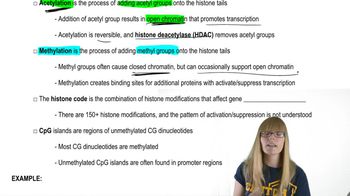Table of contents
- 1. Introduction to Genetics51m
- 2. Mendel's Laws of Inheritance3h 37m
- 3. Extensions to Mendelian Inheritance2h 41m
- 4. Genetic Mapping and Linkage2h 28m
- 5. Genetics of Bacteria and Viruses1h 21m
- 6. Chromosomal Variation1h 48m
- 7. DNA and Chromosome Structure56m
- 8. DNA Replication1h 10m
- 9. Mitosis and Meiosis1h 34m
- 10. Transcription1h 0m
- 11. Translation58m
- 12. Gene Regulation in Prokaryotes1h 19m
- 13. Gene Regulation in Eukaryotes44m
- 14. Genetic Control of Development44m
- 15. Genomes and Genomics1h 50m
- 16. Transposable Elements47m
- 17. Mutation, Repair, and Recombination1h 6m
- 18. Molecular Genetic Tools19m
- 19. Cancer Genetics29m
- 20. Quantitative Genetics1h 26m
- 21. Population Genetics50m
- 22. Evolutionary Genetics29m
13. Gene Regulation in Eukaryotes
Epigenetics, Chromatin Modifications, and Regulation
Problem 4c
Textbook Question
What parts of the genome are reversibly methylated? How does this affect gene expression?
 Verified step by step guidance
Verified step by step guidance1
Identify the regions of the genome that are commonly subject to reversible methylation, such as CpG islands, which are often located near gene promoters.
Understand that methylation typically occurs on cytosine bases within CpG dinucleotides, leading to 5-methylcytosine formation.
Recognize that methylation of DNA can lead to changes in chromatin structure, often resulting in a more condensed, heterochromatic state that is less accessible to transcription machinery.
Explore how methylation of promoter regions generally suppresses gene expression by preventing the binding of transcription factors and other necessary proteins.
Consider the role of DNA demethylation processes, which can reverse methylation marks, thereby potentially reactivating gene expression by making the chromatin more open and accessible.
Recommended similar problem, with video answer:
 Verified Solution
Verified SolutionThis video solution was recommended by our tutors as helpful for the problem above
Video duration:
3mPlay a video:
Was this helpful?
Key Concepts
Here are the essential concepts you must grasp in order to answer the question correctly.
DNA Methylation
DNA methylation is a biochemical process involving the addition of a methyl group to the DNA molecule, typically at cytosine bases. This modification can influence gene expression by altering the accessibility of the DNA to transcription factors and other regulatory proteins. Methylation patterns can be stable or reversible, playing a crucial role in cellular differentiation and development.
Recommended video:
Guided course

DNA Proofreading
Reversible Methylation
Reversible methylation refers to the dynamic nature of DNA methylation, where methyl groups can be added or removed from the DNA. Enzymes such as DNA methyltransferases add methyl groups, while demethylases can remove them. This reversibility allows cells to respond to environmental changes and regulate gene expression in a flexible manner, impacting processes like development and adaptation.
Recommended video:
Guided course

Histone Protein Modifications
Gene Expression Regulation
Gene expression regulation involves the mechanisms that control the transcription of genes, determining when and how much of a gene product is produced. Methylation can silence genes by preventing transcription factors from binding to the DNA, thereby reducing or eliminating gene expression. Understanding how reversible methylation affects gene expression is essential for grasping the complexities of genetic regulation and its implications in health and disease.
Recommended video:
Guided course

Penetrance and Expressivity





